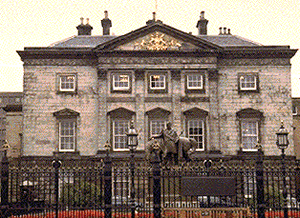William Chambers

- Dundas House, Edinburgh
- [click on the picture to enlarge it]
William Chambers (1723-96) was the most cosmopolitan among British architects of his time. He was born in Sweden into the family of a Scottish merchant, and he travelled in the East from an early age, visiting China ; he then studied architecture in Paris under J-F. Blondel. From 1750 to 1755 he stayed in Italy, becoming acquainted in Rome with such pioneers of neoclassicism as Clérisseau and Le Geay.
When he was back in London, Chambers quickly gained the patronage of the royal family, primarily by adorning Kew gardens with numerous pavilions, among others the famous Pagoda (1762). He was at the same time appointed architect of the Crown, and eventually Surveyor of the King’s Works in 1782. He soon emerged as Robert Adam’s great rival, though he did not obtain so many commissions for country houses from the nobility. He had to be content with renovating older houses (Milton Abbey, 1771-76, in ‘gothic ‘ style), or designing pavilions (the admirable ‘Casino’ of Marino House, Dublin).
Chambers’s most remarkable buildings mostly belong to urban architecture. He built several town houses, in Edinburgh (Dundas House, 1771-74, now the Royal Bank of Scotland), in Dublin (Charlemont House, 1763-75) as well as in London (Gower House, 1765-74). His main achievement in London, however, was a public building, Somerset House (1776-96), a vast complex between the Strand and the Thames, housing both the Royal Academy of Arts (of which Chambers was the first Treasurer) and Admiralty Offices.
His style, though at first sight unoriginal, can be defined as a synthesis of British neopalladianism and international neoclassicism, which gives his best buildings both elegance of proportions and sobriety in decoration, as befits such an austere and exacting master. Among his publications mention should be made of the last great architectural treatise of the century, A Treatise of Civil Architecture (1759).

